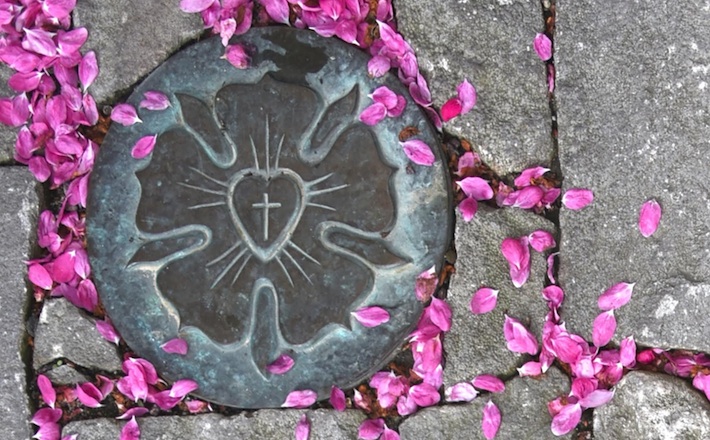Commentary on Jeremiah 31:31-34
Rembrandt’s famous Jeremiah Lamenting the Destruction of Jerusalem captures what most of us picture when we think of the biblical Jeremiah: the prophet, forlorn, painted against a dark background, leans his head on his hand.
It’s an image of abandoned hope, one that reflects the noun created out of Jeremiah’s name: jeremiad, “a long, mournful complaint or lamentation” (see Figure 1). Jeremiah, after all, is the prophet who tradition credits with writing the book of Lamentations, whose mournful tone is also reflected in the sorrowful book that bears the prophet’s name. This is the prophet who cries, “Therefore thus says the LORD: See, I am laying before this people stumbling blocks against which they shall stumble; parents and children together, neighbor and friend shall perish” (Jeremiah 6:21) and “Woe to the shepherds who destroy and scatter the sheep of my pasture!” (Jeremiah 23:1). It’s no wonder that Jeremiah is often called the “Weeping Prophet.”
Yet despite Jeremiah’s nickname, we find in the middle of the book a passage with a very different tone: Jeremiah 30-31. These chapters often take the reader by surprise, for they are filled with comfort, hope, and optimism. Following such dire pronouncements such as “I will attend to you for your evil doings, says the LORD” (Jeremiah 23:2), the promises found in what is often called the “Little Book of Comfort” are both surprising and welcome. Within sits Jeremiah 31:31-34, often-labeled “The New Covenant” in study bibles and commentaries. These four verses brim with faith for the future: “The days are surely coming, says the LORD, when I will make a new covenant with the house of Israel and the house of Judah … ” and, perhaps most strikingly, an astonishing divine promise: “I will forgive their iniquity, and remember their sin no more.”
If the particular pericope from Jeremiah 31:31-34 sounds familiar, it is likely because we’ve heard it before, but perhaps not from the book of Jeremiah. Rather, our familiarity with the passage might stem from Hebrews 8:8-12, where the Jeremianic passage is reused. (Readers should note, however, that the author of Hebrews appears to draw on the Septuagint [LXX] rather than the Masoretic Text [MT] of Jeremiah — especially in the change from 31:32, “though I was their husband, says the Lord” to Hebrews 8:9, where the text reads instead, “and so I had no concern for them, says the Lord.”) Set within the context of the New Testament book of Hebrews, the passage from Jeremiah 31:31-34 is fundamentally reinterpreted: the “old” is now overturned and replaced by the “new,” and suddenly God is turned from Israel’s husband to one who has no concern for the people. Hebrews 8:13 summarizes this reading: “In speaking of ‘a new covenant,’ he has made the first one obsolete. And what is obsolete and growing old will soon disappear.” Yet this is not what the hopeful passage from Jeremiah means in its original context.
According to the book that bears his name, Jeremiah’s call occurs in the “thirteenth year” of King Josiah’s reign (Jeremiah 1:1), approximately 627 BCE, and he is active through the fall of Jerusalem to Babylon in 587 BCE, remaining in the land until after the assassination of Gedaliah (Jeremiah 41), at which point he is forced into exile in Egypt and the book ends without recounting the prophet’s ultimate fate. In other words, according to the book, the prophet is active centuries before the author of Hebrews put pen to papyrus, and lives through one of the most turbulent and catastrophic moments in ancient Israel’s history. So what place does such hope have in the book of Jeremiah, and what might a “new covenant” have meant?
To begin, in the Jeremianic passage the promise of a new covenant is not something entirely different from the preceding covenant between God and Israel, but rather a reformulation of what came before it, one linked with it. After all, God promises “I will put my law (to^ra¯t_i^) within them, and I will write it on their hearts; and I will be their God, and they shall be my people” (Jeremiah 31:33). “My law” is perhaps best translated as “my teaching” or “my Torah,” and connects the promise of this new covenant with the preceding covenant between Israel and Israel’s God. The covenantal arrangement promised in Jeremiah 31:31-34 will be different, to be sure (“I will put my law within them, and I will write it on their hearts,” compared with the commandment of Deuteronomy 11:18, for example, where humans must fix God’s words into their hearts and minds). Yet for the author of the passage, Yhwh remains Israel’s God, and Israel remains Yhwh’s people, just as before. The continuity of the promise is further stressed in the opening of Jeremiah 31:34, “No longer shall they teach one another, or say to each other, ‘Know the Lord,’ for they shall all know me … ” This new covenant continues the story of Israel from before. In this new formulation of the covenant, everyone, “from the least of them to the greatest” will have equal access and, unlike for those who lived in the world of pre-587 BCE, forgiveness is assured for all: “I will forgive their iniquity, and remember their sin no more” (Jeremiah 31:34).
The astounding promise of forgiveness returns us to Rembrandt’s Jeremiah, forlorn, painted against a dark background, head on hand. The promise of such a radically new and hopeful covenant does not sound like words that Rembrandt’s grim Jeremiah might utter, yet Rembrandt’s Jeremiah is only one snapshot of the book. Equally complex is the portrait of God in the book of Jeremiah (and in the Hebrew Bible more broadly). The depiction of God that emerges in this passage is one of a healer, who forgives and restores a broken relationship, even if the fault for the break might rest on the people. For the first audiences of Jeremiah 31:31-34, the divine promise of “the new covenant” might be set in the future, but it does not seem to be a far-off future.
As we consider this passage, we might try to imagine being exiled, far from our home and wondering what will become of us. The “new covenant” of Jeremiah 31:31-34 might seem strangely hopeful and consoling in the book of the “Weeping Prophet,” but the passage is a reminder that Jeremiah’s book offered the ancient Israelites the hope of a new covenant and a continued relationship with Yhwh, even in the midst of exile. For the original survivors, such a promise must have provided balm and comfort in the face of despair.
The book of Jeremiah was written in a specific place and context, offering hope to the exiled Judeans that the covenant with their God would continue in a new fashion, mended after the disaster of 587 BCE. Yet the book of Jeremiah also transcends its context. The words of comfort in Jeremiah 31:31-34 can speak to all of us who are suffering in the world now, to all of us who might feel like Rembrandt’s Jeremiah. After all, no matter how broken the world might seem, “the days are surely coming, says the LORD … ”
Figures
Figure 1: Rembrandt van Rijn, Jeremiah Lamenting the Destruction of Jerusalem, 1630

“Jeremiah lamenting the destruction of Jerusalem” by Rembrandt Harmenszoon van Rijn, 1630. Public domain image accessed at https://commons.wikimedia.org/


October 30, 2016